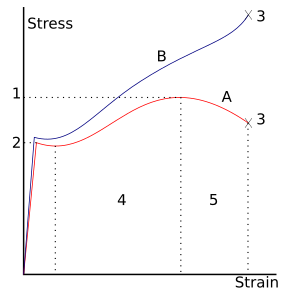
Back لدونة Arabic Plastiklik (fizika) Azerbaijani Пластычная дэфармацыя Byelorussian Плястычная дэфармацыя BE-X-OLD Пластична деформация Bulgarian অস্থিতিস্থাপকতা (নমনীয় পদার্থ) Bengali/Bangla Plasticitat Catalan Тӳсĕмлĕх (физика) CV Plastizität (Physik) German Plasta aliformiĝo Esperanto


- Ultimate strength
- Yield strength (yield point)
- Rupture
- Strain hardening region
- Necking region
- Apparent stress (F/A0)
- Actual stress (F/A)
| Part of a series on |
| Continuum mechanics |
|---|
In physics and materials science, plasticity (also known as plastic deformation) is the ability of a solid material to undergo permanent deformation, a non-reversible change of shape in response to applied forces.[1][2] For example, a solid piece of metal being bent or pounded into a new shape displays plasticity as permanent changes occur within the material itself. In engineering, the transition from elastic behavior to plastic behavior is known as yielding.
Plastic deformation is observed in most materials, particularly metals, soils, rocks, concrete, and foams.[3][4][5][6] However, the physical mechanisms that cause plastic deformation can vary widely. At a crystalline scale, plasticity in metals is usually a consequence of dislocations. Such defects are relatively rare in most crystalline materials, but are numerous in some and part of their crystal structure; in such cases, plastic crystallinity can result. In brittle materials such as rock, concrete and bone, plasticity is caused predominantly by slip at microcracks. In cellular materials such as liquid foams or biological tissues, plasticity is mainly a consequence of bubble or cell rearrangements, notably T1 processes.
For many ductile metals, tensile loading applied to a sample will cause it to behave in an elastic manner. Each increment of load is accompanied by a proportional increment in extension. When the load is removed, the piece returns to its original size. However, once the load exceeds a threshold – the yield strength – the extension increases more rapidly than in the elastic region; now when the load is removed, some degree of extension will remain.
Elastic deformation, however, is an approximation and its quality depends on the time frame considered and loading speed. If, as indicated in the graph opposite, the deformation includes elastic deformation, it is also often referred to as "elasto-plastic deformation" or "elastic-plastic deformation".
Perfect plasticity is a property of materials to undergo irreversible deformation without any increase in stresses or loads. Plastic materials that have been hardened by prior deformation, such as cold forming, may need increasingly higher stresses to deform further. Generally, plastic deformation is also dependent on the deformation speed, i.e. higher stresses usually have to be applied to increase the rate of deformation. Such materials are said to deform visco-plastically.
- ^ Lubliner, Jacob (2008). Plasticity theory. Dover. ISBN 978-0-486-46290-5.
- ^ Bigoni, Davide (2012). Nonlinear Solid Mechanics: Bifurcation Theory and Material Instability. Cambridge University Press. ISBN 978-1-107-02541-7.
- ^ Jirásek, Milan; Bažant, Zdeněk P. (2002). Inelastic analysis of structures. John Wiley and Sons. ISBN 0-471-98716-6.
- ^ Chen, Wai-Fah (2008). Limit Analysis and Soil Plasticity. J. Ross Publishing. ISBN 978-1-932159-73-8.
- ^ Yu, Mao-Hong; Ma, Guo-Wei; Qiang, Hong-Fu; Zhang, Yong-Qiang (2006). Generalized Plasticity. Springer. ISBN 3-540-25127-8.
- ^ Chen, Wai-Fah (2007). Plasticity in Reinforced Concrete. J. Ross Publishing. ISBN 978-1-932159-74-5.


